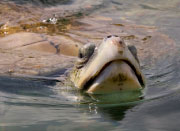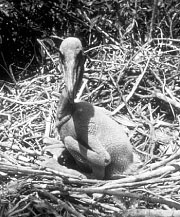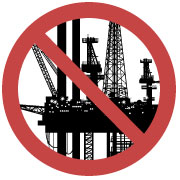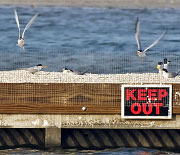 |
||||||||
Hoping for the Best, Preparing for the Worst
 Ninety-four miles off the Pinellas coast, the Coast Guard patrols an imaginary line in the water, watching for oil from the BP Deepwater Horizon spill to appear. Watchers glimpsed a slight sheen once about 150 miles offshore, but the oil moved away before it triggered a series of actions designed to protect Tampa Bay and the region’s beaches.
Ninety-four miles off the Pinellas coast, the Coast Guard patrols an imaginary line in the water, watching for oil from the BP Deepwater Horizon spill to appear. Watchers glimpsed a slight sheen once about 150 miles offshore, but the oil moved away before it triggered a series of actions designed to protect Tampa Bay and the region’s beaches.
At this point the only thing that is clear about the oil spill is that there are no clear answers. Even once the spill is contained, millions of gallons of oil will have been released in the Gulf of Mexico where it will have unknown consequences for at least decades to come.
 Endangered sea turtles, like this Kemp-Ridley shown surfacing for air, have been adversely impacted since the oil spill although scientists aren’t sure what is killing them in larger numbers than usual.
Endangered sea turtles, like this Kemp-Ridley shown surfacing for air, have been adversely impacted since the oil spill although scientists aren’t sure what is killing them in larger numbers than usual.
Photo by Bonnie Strawser, US Fish and Wildlife Service
Responders are removing sea turtle eggs from nests along the gulf coast. When the turtles hatch, they’ll be released in the Atlantic Ocean where they will avoid exposure to oil.
The geographic location of Tampa Bay region, with a wide continental shelf that somewhat deflects normal summer currents, means our beaches and bay are perhaps more protected than any area on the Gulf of Mexico. And the 500 miles of open water separating us from the spill means that the most likely scenario here will be tar balls not oil or mousse that coats birds and other wildlife.
A July 5 report from the National Oceanic and Atmospheric Administration indicates that there is a less than 20% chance of oil coming ashore near Tampa Bay, although there is a 60-80% chance of tar balls or weathered oil coming ashore in the Florida Keys or the state’s east coast.
The US Fish and Wildlife Service indirectly confirmed that assessment on July 6 when they released 32 pelicans at Fort DeSoto County Park. The birds, which had been captured after being oiled, were rehabilitated at Fort Jackson Wildlife Center at Buras, La. That was the third release of oiled birds in Tampa Bay, following two releases that occurred at Egmont Key at the mouth of the bay.
Still Not Totally Clear
Although chances for damage to beaches in the region are low, a strong hurricane coming from the wrong direction can change that situation practically overnight. That makes advance preparation critical even though it’s still primarily a watch-and-wait situation.
“We’ll need to clean the entire coastline in less than 36 hours, so we’ll need an enormous number of people pre-registered and ready to go,” says Bill Sanders, executive director of Keep Pinellas Beautiful. “The Coast Guard will give us 72 hours notice from when they expect the oil to arrive, then they want the beaches clean 24 hours before the oil comes ashore.”
About 4500 people already have registered but Sanders expects that only about two of every five registrants will be available when they’re needed. “We can’t plan this for a weekend when people aren’t working, and other people may need to get their homes ready for the hurricane or even to evacuate themselves,” he notes.
As volunteers from Keep Pinellas Beautiful scour debris from the beach and nearby neighborhoods and shopping centers, volunteers from the Suncoast Seabird Partnership will be on hand to protect vulnerable seabird nests. “We’ve already GPS’d (located by global position satellite) every nest and colony in Pinellas County,” said Lorraine Margeson, a member of the Suncoast Seabird Partnership.
“If you don’t know what you’re looking for, it’s almost impossible to see tiny snowy plover eggs on sand,” she said.

Photo by Donna Dewhurst, US Fish and Wildlife Service.
About 10,000 pairs of pelicans nest in Florida every winter, including large colonies in the Tampa Bay region. Ironically, the estimated 15,000 pairs living in Louisiana were relocated there from Florida after the local population was nearly extinct before the Endangered Species Act passed.
Taking a Long-Term Look
Local groups also are taking advantage of the massive amount of attention generated by the BP spill to tackle other issues. For instance, Tampa Bay Watch is working to expand the pool of volunteers trained to deploy boom around Cockroach Bay, one of the region’s most important nature preserves.
“We think the real issue is another spill in Tampa Bay, at Port Manatee or in the shipping channel like that in 1993, but the Deepwater Horizon spill gives us the chance to grow our volunteer base so we have trained people on hand if we need them,” said Peter Clark, TBW executive director.
Sanders is also taking advantage of the attention and has scheduled the first-ever cleanup of the entire Intracoastal Waterway in Pinellas County on July 17. More than 150 boats are expected, ranging from canoes and kayaks to larger vessels that can carry multiple volunteers to islands where litter accumulates.
Additionally, Sanders hopes the oil spill will remind people that almost everything that goes into a storm drain ends up as pollution in the county’s lakes, rivers, streams, bays and beaches. “We all need to be aware that litter from practically anywhere in Pinellas County can end up on our beaches if a storm comes through.”
 How to Help:
How to Help:
Prospective volunteers can sign up to be notified when they’re needed at several websites including: www.volunteerfloridadisaster.org which is the statewide organization that also offers links for volunteers to sign up on a county-by-county basis.
www.pinvol.org and www.tampabaywatch.org in Pinellas and Hillsborough counties. Volunteers who register online would be contacted for a cleanup event 72 hours prior to an expected landfall of oil on the Pinellas shoreline. Volunteers for the July 17 Intracoastal cleanup are asked to register by telephone so that organizers can match available seats on boats with people who need rides. Call 727-533-0402.
Volunteers can sign up for multiple shoreline cleanups (not necessarily related to the oil spill) around the Tampa Bay area by registering with the Mayor’s Beautification Program at www.mbptree.org.
Other organizations reaching out for assistance include:
Audubon of Florida needs experienced wildlife observers to monitor nighttime cleanup on the Panhandle. Observers must have a background in practical field experience as a professional or a volunteer. Training will be provided to people selected for these paid positions. Learn more at www.fl.audubon.org.
Volunteer beach stewards at Pinellas County are needed to help document bird nests and colonies, as well as to help prevent people from entering fenced areas that protect nesting birds. Visit www.flshorebirdalliance.org or email forysea@eckerd.edu or donlocomm@aol.com. Local volunteers also are needed to keep a record of local bird populations using the eBird checklist at www.ebird.org or call the Clearwater Audubon Society at 727- 431-2856.
Tampa Bay Watch is coordinating beach watchers at www.tampabaywatch.org. Volunteers are needed at the Suncoast Seabird Sanctuary for tasks such as feeding birds and answering the phone to free up trained staff for emergency work. They also need donations of linens, kennels, towels, sheets, Dawn dish detergent, Pepto-Bismol and toothbrushes. Veterinarians and wildlife paraprofessionals are asked to pre-register and complete the training needed to clean oiled birds. Visit www.seabirdsanctuary.com or call 727-391-2473.
Save Our Seabirds, under the direction of former Pinellas County resident Lee Fox, had an 85% success rate for oil-slicked seabirds after the 1993 oil spill in Tampa Bay. The organization is accepting donations and asking trained volunteers to sign up for a planned trip to the Panhandle. Additional volunteers also will be needed to care for birds in Sarasota while staff is out of town. Visit saveourseabirds.org or call 941-388-3010.
The Clearwater Marine Aquarium is looking for volunteers who can help with daily duties to free up trained staff to assist oiled wildlife. Training classes and long-term weekly shifts are required. Visit www.seewinter.com or call 727- 441-1790, ext. 230.
For More Information:
Daily newspapers and television accounts have covered every topic relating to the BP oil spill extensively but several websites offer more in-depth information updated constantly.
www.deepwaterhorizonresponse.com – The federal government has created a unified command with the US Coast Guard as the lead agency in an organization that includes National Oceanic and Atmospheric Administration, the Environmental Protection Agency, Department of the Interior and its Minerals Management Service, US Geological Survey, US Fish and Wildlife Service and the Center for Disease Control.
www.nhc.noaa.gov – Along with the ubiquitous “bubble” predictions from the National Hurricane Center that show where the eye of a storm is likely to land, a separate graphic provides a map of areas that are likely to see wind speeds of 50 knots or more over the next 120 hours.
http://sero.nmfs.noaa.gov – Another NOAA site that details boundaries on areas closed to fishing.
http://ocgweb.marine.usf.edu/ – A site developed and maintained by the USF College of Marine Science’s Ocean Circulation Group with model-based, oil spill trajectory forecasts, updated daily with new wind forecasts and satellite-derived oil location information.
http://www.dep.state.fl.us/deepwaterhorizon/ – Reports on Florida activities, forecasts and current concerns, updated twice a day.
http://www.deepwaterhorizonresponse.com/go/doctype/2931/55963 – Reports on wildlife impact updated daily from the unified command.
www.mote.org/beaches – Reports from beaches across the state uploaded daily.
 Regional Planning Council Unanimously Passes Resolutions Against Drilling in Eastern Gulf
Regional Planning Council Unanimously Passes Resolutions Against Drilling in Eastern Gulf
The Tampa Bay Regional Planning Council unanimously voted in favor of resolutions that oppose expanded drilling in the eastern Gulf of Mexico and require Best Available Technology on wells that are currently operating.
The resolutions were initially drafted by the council’s Agency on Bay Management based on resolutions already approved by member governments.
The first resolution notes that the risk of damage to the environment and the region’s economy is so significant that no new area in the Gulf of Mexico should be open to future oil and gas production leases. Currently, the Gulf of Mexico Energy Security Act of 2006 provides a moratorium on oil and gas leasing in any area east of the Military Mission Line (234 miles from the Tampa Bay region) and in any area within 125 miles of the Florida coastline.
A second resolution recognizes that the current Deepwater Horizon oil spill was caused by a combination of human error, equipment failure and the lack of sufficient safety precautions and fail-safe mechanisms, all of which were made more likely by gaps in federal regulations and lapses in federal enforcement.
The TBRPC resolution calls for new federal regulations requiring the use of Best Available Technology on all existing wells and drilling equipment. It also calls for a complete review of all spill management regulations and protocols to ensure that they reflect the best use of technology and knowledge, specifically regarding the use of dispersants, booming and other deflection and collection technology.

Photo by Lorraine Margeson
Least terns land on a floating platform moored near one of their favorite nesting sites at Fort DeSoto Park.
Good News, Bad News for Least Terns
A nesting platform for least terns, deployed before the BP Transocean disaster on April 20, has surpassed expectations of the St. Petersburg Audubon Society members who launched it.
“We’ve got one, or maybe two pairs who are thinking of nesting on it,” said Lorraine Margeson, an Audubon member who worked with Fort DeSoto park ranger Jim Wilson to build the 16-by-24-foot floating dock near a spot where terns already are nesting.
“We’re excited that they’re even landing on it this year,” she said. “We thought we would put it out and they’d fly over it to get used to it even if they never landed on it.”
With the oil spill destroying nests of shorebirds on other parts of the Gulf of Mexico, helping protect the birds on Tampa Bay’s beaches has become more important than ever.
“We’re working very hard to make this year as productive as possible for the birds,” she said. “We don’t know what’s going to happen next year.”
With nests scraped into sand along the shoreline, birds like the least tern and snowy plover are the species most likely to be impacted by the oil. Even if the oil arrives after their nestlings have flown off, Margeson worries about the impact of oily residues on the fish they feed upon.
“Nobody knows what’s going to happen to the glass minnows and other little creatures that live on the shore, and if they’re not there, who knows what the birds will eat.”
